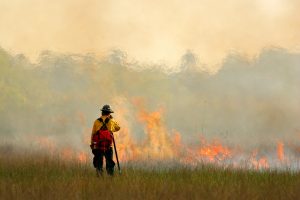Once again, wildfires are a huge problem in the U.S. According to the National Interagency Fire Center, seven new large fires were reported on Sunday, which brings the national total to 91 large fires that have burned 1.8 million acres.
Businesses shouldn’t wait for a wildfire to occur before putting in place an evacuation plan, according to the Occupational Safety and Health Administration (OSHA). On its wildfires preparedness page, OSHA says a thorough evacuation plan should include:
- Conditions that will activate the plan
- Chain of command
- Emergency functions and who will perform them
- Specific evacuation procedures, including routes and exits
- Procedures for accounting for personnel, customers, and visitors
- Equipment for personnel
- Review the plan with workers
Emergency Action Plan
Some businesses are required to have an emergency action plan (EAP) meeting the requirements under 209 CFR 1919.38; see the Evacuation Plans and Procedures eTool for more information. When developing an EAP, keep in mind that a very simple plan will suffice in offices, small retail shops, and small manufacturing settings where are few or no hazardous materials or processes, and employees are evacuated when alarms go off or when notified by public address systems. More complex plans are required in workplaces that contain hazardous materials or workplaces where employees fight fires, perform rescue and medical tasks, or delay evacuation after alarms sound to shut down critical equipment.
The EAP must be site specific with respect to emergency conditions evaluated, evacuation policies and procedures, emergency reporting mechanisms, and alarm systems. OSHA provides an EAP checklist that identifies issues that must be considered when drafting a comprehensive EAP.
In addition to creating an evacuation plan, making a safety zone around your business can help protect people and property. Within a 30-foot zone of buildings, remove combustible material and reduce the volume of vegetation to a minimum, according to OSHA.
Authority
You’ll need to select a responsible individual to lead and coordinate your emergency plan and evacuation. Employees must know who the coordinator is and understand that this person has the authority to make decisions during emergencies. The coordinator should be responsible for assessing the situation to determine whether the emergency procedures should be activated, overseeing emergency procedures, notifying and coordinating with outside emergency services, and directing shutdown of utilities or plant operations if necessary.
In other cases, local emergency officials such as the local fire department may order you to evacuate your premises. Listen to newscasts on radio or television to stay informed and follow any official orders you receive.
When emergency officials, such as the local fire department, respond to an emergency at your business, they will assume responsibility for the safety of building occupants and have the authority to make decisions regarding evacuation and whatever other actions are required. The highest-ranking responder will assume the incident command role and will work with the onsite emergency coordinator, but will be responsible for directing all response activities.
Training and Plan Review
Before reviewing the EAP, the employer must designate and train enough people to assist in the safe and orderly evacuation of employees. The plan should be reviewed with each employee when the initial plan is developed and when each employee is initially assigned to the job. Also, the plan should be reviewed with each employee when their actions or responsibilities under the plan change or when the plan changes. Effective plans often call for retraining employees annually and include drills in which employees can practice evacuating their workplace and gathering in the assembly area.
General training for your employees should also address the following:
- Individual roles and responsibilities
- Threats, hazards, and protective actions
- Notification, warning, and communications procedures
- Means for locating family members in an emergency
- Emergency response procedures
- Evacuation, shelter, and accountability procedures
- Location and use of common emergency equipment
- Emergency shutdown procedures
You may also want to train your employees in first-aid procedures, including protection against bloodborne pathogens; respiratory protection; and methods for preventing unauthorized access to the site.
Once everyone has been properly trained, hold practice drills as often as necessary to keep employees prepared. Include outside agencies such as fire and police departments if possible. After each drill, gather management and employees to evaluate the effectiveness of the drill.

